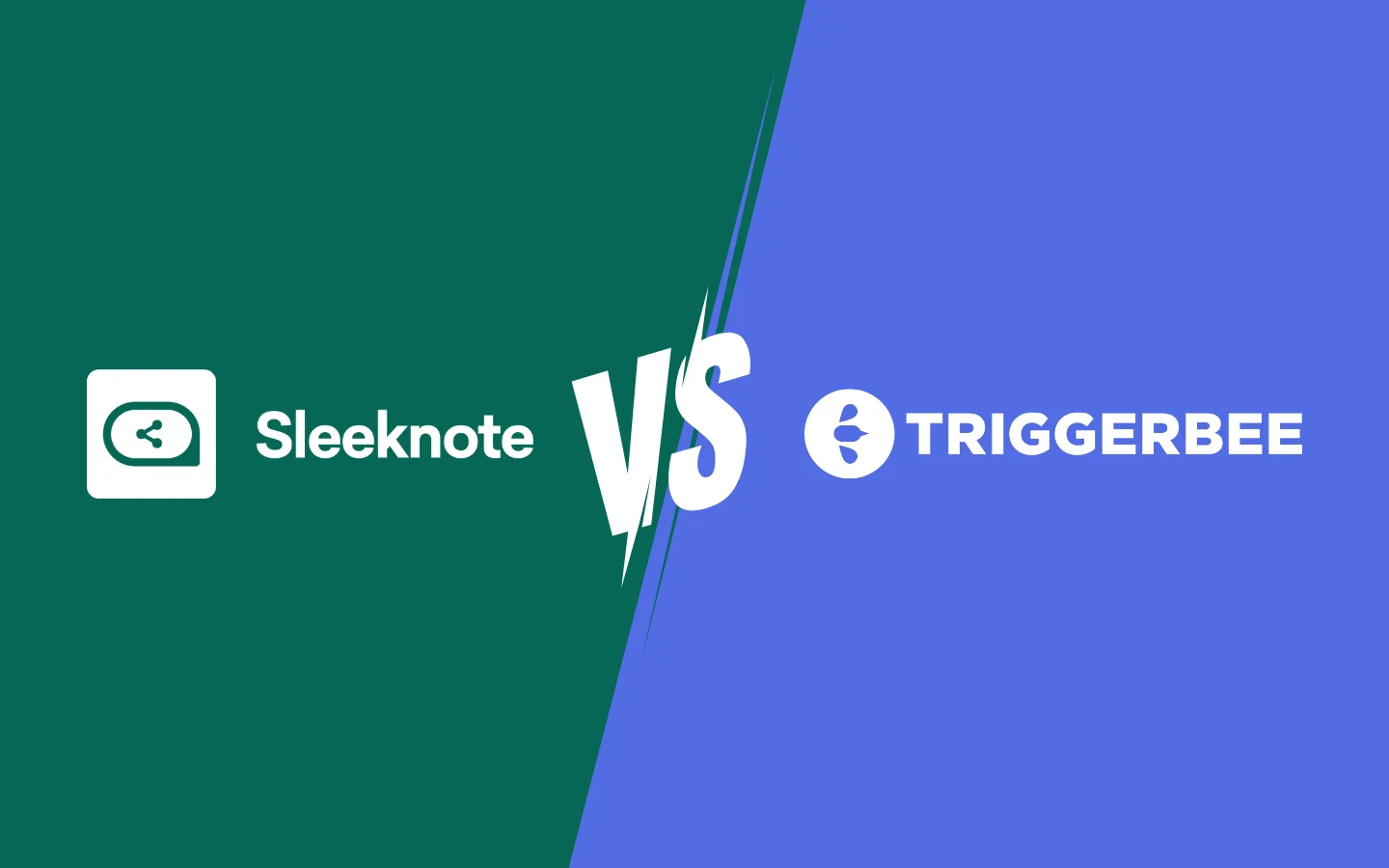In this article we’ll compare Sleeknote vs Triggerbee, two of the most powerful softwares for onsite marketing, lead gen, gamification and visitor engagement on the market today. Both tools offer powerful capabilities, and while you can reach your goals with both tools, there are some differences you might want to know about.
This guide breaks down where each platform shines, and why many growing ecommerce brands looking for a Sleeknote alternative are turning to Triggerbee. With more personalization options, stronger analytics, and some serious cost-savings (up to €430 per year), Triggerbee might be the smarter choice for your team.
Sleeknote vs Triggerbee: Summary
| Feature | Triggerbee | Sleeknote |
|---|---|---|
| Campaign Types (popups, embeds) | ✅ Popups, Embeds, Callouts, Full screen, Banners | ✅ Popups, Embeds, Full screen, Bars |
| Forms | ✅ Yes | ✅ Yes |
| Promotions | ✅ Yes | ✅ Yes |
| Gamification | ✅ Spin to win, Memory, Product quizzes, Calendars, Daily offers | ✅ Advent Calendar, Spin to win, Scratch to Win, Daily offers |
| Surveys | ✅ CSAT & NPS with analytics, Ratings, Smileys, Thumbs, Stars + feedback field | ✅ Simple surveys, NPS |
| Referral marketing | ✅ Yes | ❌ No |
| Targeting | ✅ Session behavior, profile properties and events | ✅ Behavioral triggers, page-level, SiteData |
| Advanced Onsite Targeting | ✅ Weather targeting, Geolocation, CRM data | ✅ Geolocation, SiteData |
| Smart Embeds | ✅ Yes, audience-targeted content injected via CSS class | ❌ Regular embeds |
| Personalization Features | ✅ CRM-targeting, Customer Profile Targeting | ✅ Text replacement, SiteData |
| A/B Testing | ✅ A + B | ✅ Multivariate |
| Analytics & Reporting | ✅ Revenue attribution, funnel analysis | ✅ Simple conversion & engagement |
| Product recommendations | ✅ With integrations | ✅ Via Shopify, Clerk, Raptor, Hello Retail |
| Brand Default Styles | ✅ Yes | ❌ No |
| Integrations | ✅ Multiple native + Zapier | ✅ Multiple native + Zapier |
| Freemium | ❌ No | ❌ No |
| Free Trial | ✅ 14 days and 250k page views | ✅ 14 days |
| Pricing | Starts at €39 | Starts at $49 |
| Best For | Brands that want more personalization, customization and CRM-based targeting | SMBs that want popups, promotions and gamification |
1. Who Each Tool Is Best For
Choosing between Sleeknote and Triggerbee depends on your goals, team size, and how far you want to go with personalization. Both tools cover the essentials of popup creation and lead capture, but they’re built with different users in mind. Sleeknote is ideal for marketers who want to move fast with polished templates and simple campaigns. Triggerbee is better suited for brands ready to use behavioral data and CRM insights to deliver personalized, high-converting experiences across their site.
Sleeknote is great for small to mid-sized SMB’s or ecommerce teams that want a fast, simple way to run popups, promotions, and lead forms. It’s ideal for marketers focused on lead capture without the need for deep personalization or CRM integration.
Triggerbee is built for growth-focused brands that want to improve their onsite experience. If you care about creating fully personalized, data-driven experiences for different audience segments – especially logged-in users – Triggerbee gives you more power, more control, and better results.
2. Campaign Creation & Templates
Creating effective campaigns should be fast, flexible, and intuitive. Whether you’re building a simple popup or a multi-step flow with personalized offers, the right editor makes all the difference.
Look for tools that offer both ready-made templates and the flexibility to build from scratch, with elements like countdown timers, gamification, product blocks, and mobile-first layouts.
The more control you have in the builder, the easier it is to match your brand and launch higher-converting ideas, faster.
Campaign creation in Triggerbee
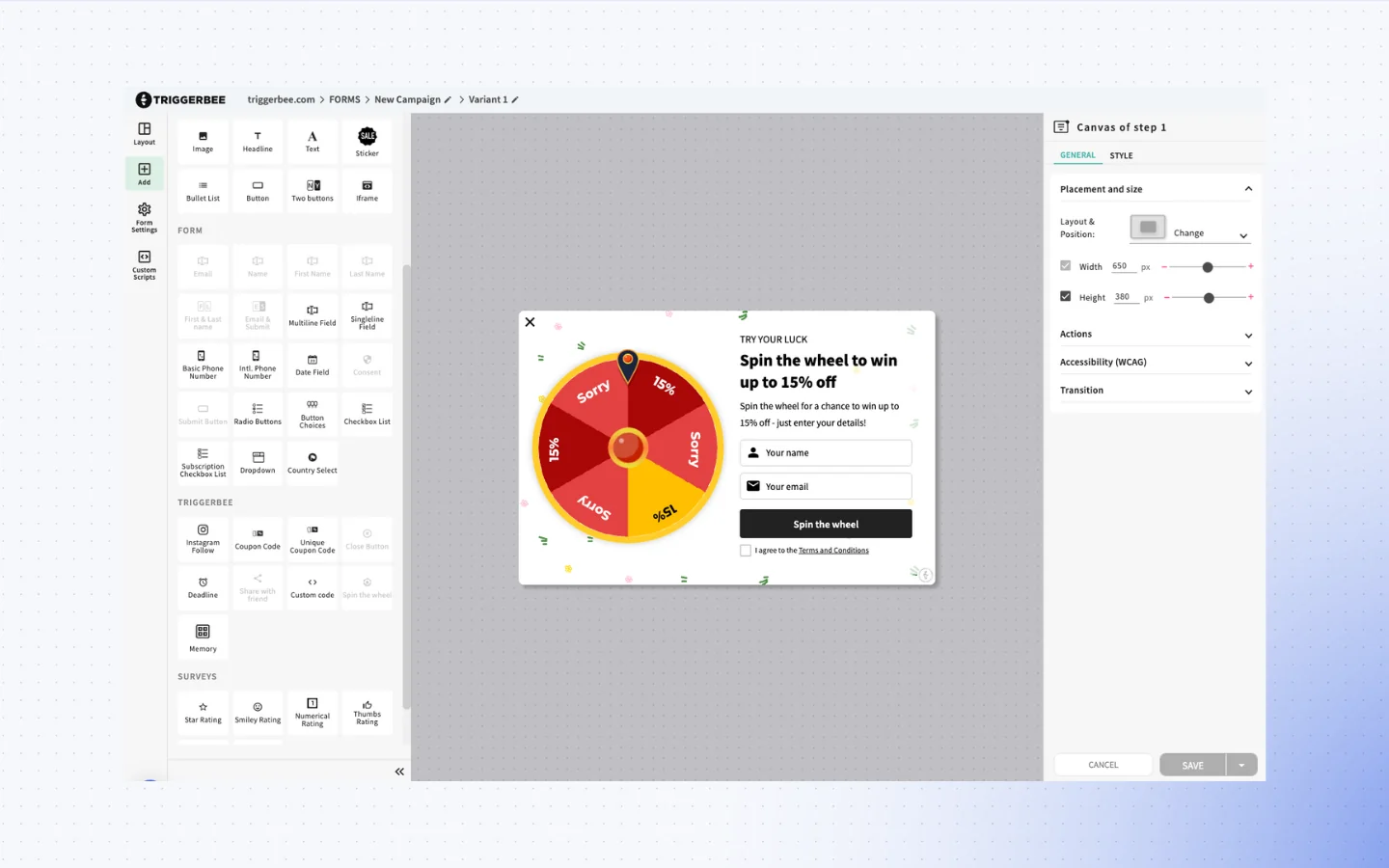
Triggerbee provides a more advanced design experience. The visual editor includes flexible drag-and-drop functionality and a full canvas interface. Layouts span Popups, Callouts, Panels, Fullscreen, and Embedded content. Templates are organized by use case (e.g., data collection, loyalty, UTM targeting), and you can start from scratch. Available elements go far beyond basics: surveys (NPS, CSAT), multistep forms, coupon delivery, personalized blocks, and CRM-synced fields – all fully editable and style-consistent with your brand profile.
Campaign creation in Sleeknote

Sleeknote’s editor features a clean campaign builder with five steps: General, Design, Display Settings, Integration, and Final Setup. Layout options include Popup, Slide-In (left/right), and Embedded. Its drag-and-drop editor offers essential layout blocks – including buttons, forms, coupon fields, quizzes, countdowns, and Shopify-integrated product recommendations. It also provides prebuilt gamification campaigns such as Spin to Win, Scratch to Win, and Daily Offers – though some require higher-tier plans.
Verdict: Sleeknote is intuitive for quick setups, with strong ecommerce presets. But Triggerbee’s editor is more powerful and customizable – especially for brands that need layered flows, advanced fields, or personalized variants.
3. Targeting & Triggers
The real power of targeting comes from combining context and intent. It’s not just about when a campaign appears, but why it appears, and who it’s shown to.
Good tools let you trigger campaigns based on behavior (like scroll depth or exit intent), session data (like time on site or device), or traffic source (like UTM tags). But GREAT tools go further by layering in CRM data, purchase history, and audience segments so your targeting reflects both real-time behavior and long-term customer context. This is where the biggest performance lift often happens.
Targeting and Triggers in Triggerbee
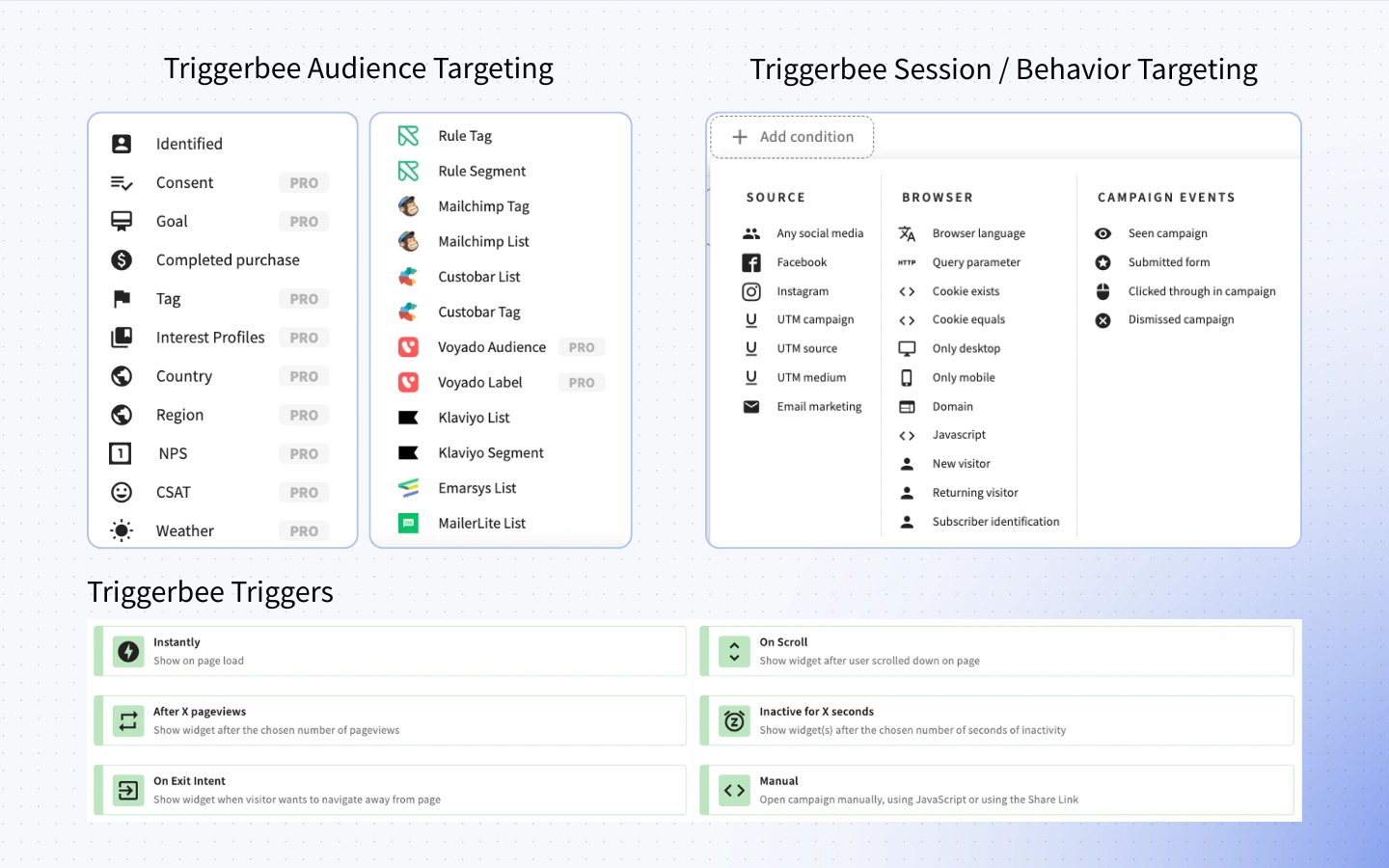
Triggerbee goes several levels deeper. Campaigns can be triggered by time, scroll, device type, inactivity, page path, UTM tag, cookie, or even custom JavaScript logic. But what sets Triggerbee apart is its hybrid model: you can combine real-time session data (like cart status or device) with persistent CRM filters (like membership status, purchase history, or survey scores). This enables pinpoint targeting such as:
- “Show this to Gold Members who abandoned cart but haven’t purchased in 30 days”
- “Only show to new visitors on mobile from Instagram ads”
- “Hide this promo for people who already redeemed their bonus”
This dual-layer system – Audience Filters (customer profile) + Session Conditions (browsing behavior) – makes Triggerbee one of the most precise tools on the market for onsite personalization.
Targeting and Triggers in Sleeknote
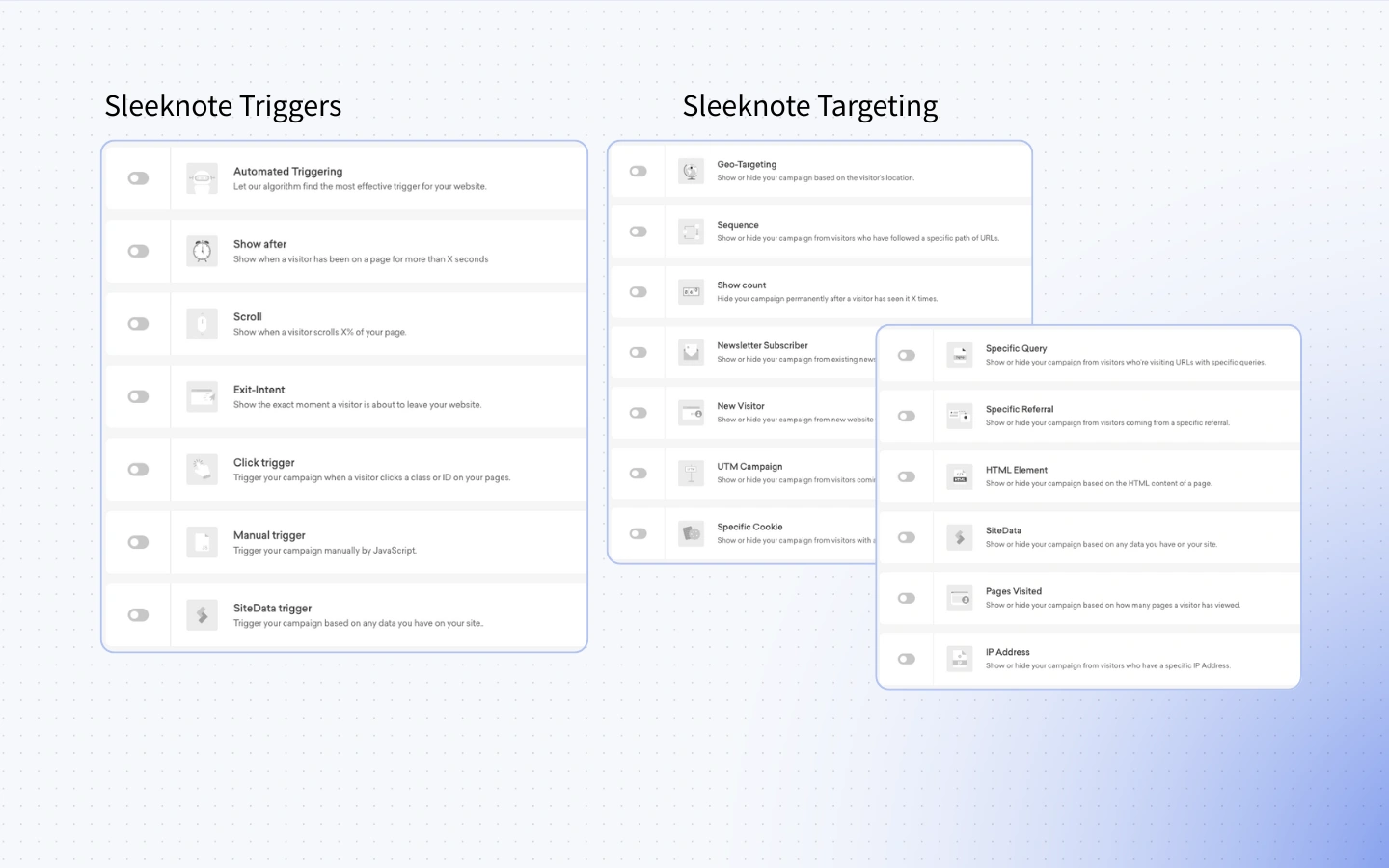
Sleeknote offers a solid range of targeting and trigger options. You can launch campaigns based on time on site, scroll depth, exit intent, click interactions, and JavaScript triggers. Targeting includes UTM campaigns, cookies, specific page visits, referrers, and geo-location. While useful, most of Sleeknote’s logic is session-based and doesn’t leverage persistent visitor profiles or CRM data. For example, a campaign can exclude users based on URL query parameters (e.g., newsletter subscribers) but cannot dynamically access CRM segments or past behavior.
Verdict: Sleeknote covers essential popup triggers and basic targeting. But if you want deeper segmentation based on user identity, CRM data, and behavior over time, Triggerbee offers unmatched targeting power.
4. Personalization Options
Personalization is about delivering the right message, offer, or experience to each visitor based on who they are, what they’ve done, and what they’re likely to do next.
Strong personalization tools connect to your CRM or customer database, let you insert dynamic content into campaigns, and give you control over which segments see what. Whether it’s showing different promotions to new vs. returning users or displaying loyalty points for logged-in members, your personalization engine should adapt to real people in real time.
Personalization in Triggerbee
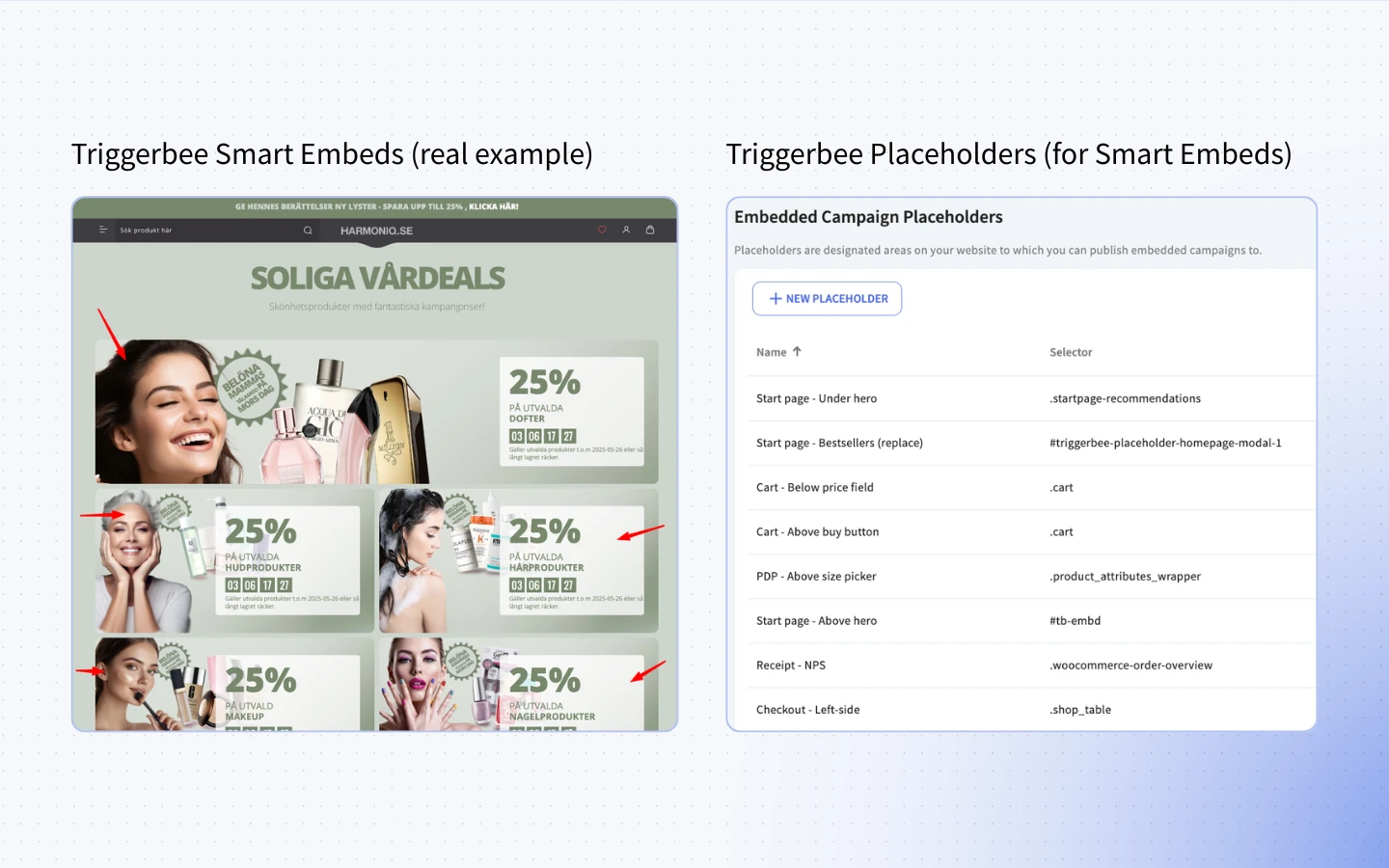
Triggerbee is built from the ground up for persistent, identity-based personalization. Campaign content can include personalized greetings, loyalty points, past purchase data, survey responses, and more – all using CRM-synced MergeTags. Campaigns can adapt in real time based on both session behavior (scroll, inactivity, device) and long-term visitor properties (like birthday month, status, tags). With built-in tools for profile enrichment, smart targeting, and dynamic content delivery, Triggerbee goes far beyond standard merge tags.
Personalization in Sleeknote
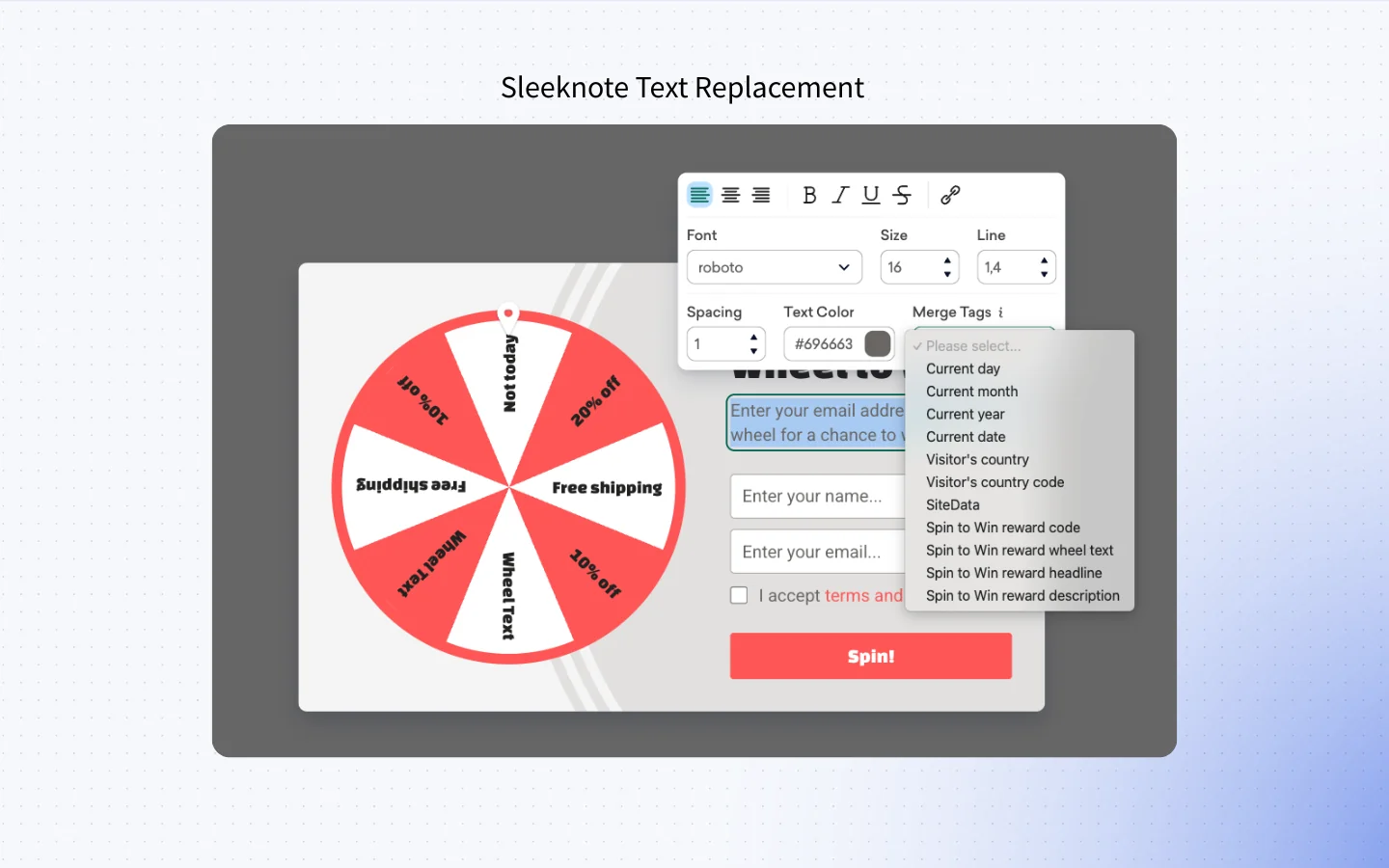
Sleeknote supports basic personalization through its SiteData functionality. You can show or hide campaigns and insert merge tags based on visitor data you send via Google Tag Manager – such as cart value, items viewed, or browser language. This allows for some dynamic display logic and in-message customization. However, all SiteData is session-based and lost after the visit ends. It also requires manual setup in your tag manager, making it more technical to implement.
Verdict: Sleeknote’s SiteData gives you basic personalization if you’re willing to do the technical setup. But if you want full-profile personalization, persistent user memory, and true one-to-one onsite experiences, Triggerbee wins by a wide margin.
5. Integrations
Your popup tool should fit into your existing tech stack — not work around it. The best platforms connect seamlessly to your CRM, email platform, and customer data sources.
Look for native integrations that support two-way syncing, audience targeting from your contact lists, and automated data handoffs. If you rely on real-time personalization or triggered emails, integration depth (not just quantity) becomes a key factor.
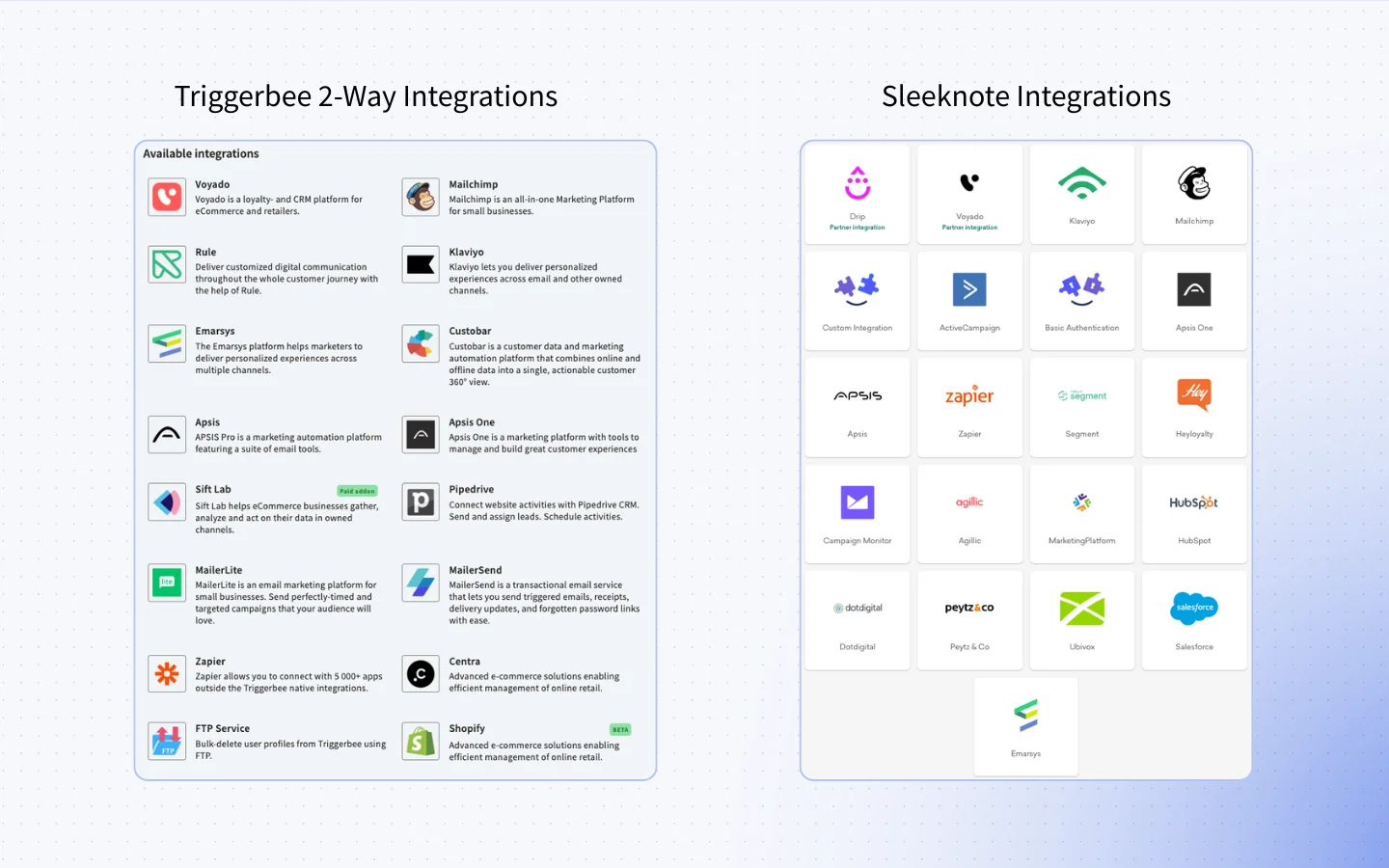
Sleeknote’s integrations
Sleeknote offers a wide range of ESPs and CRM systems commonly used in ecommerce. You’ll find native support for Shopify, Klaviyo, Mailchimp, ActiveCampaign, HubSpot, Drip, Apsis, Segment, and others – plus general connection options via Zapier, webhooks, and custom integrations.
Triggerbee’s integrations
Triggerbee offers just as broad integrations, but with a deeper focus on CRM syncing and data-driven targeting. In addition to major email platforms like Mailchimp, Klaviyo, Rule, and MailerLite, it also supports CDPs like Custobar and Segment, marketing automation tools like Emarsys and Apsis, and CRMs such as Salesforce, HubSpot, and Pipedrive. You can even bulk delete or sync users through FTP or send detailed customer data to Sift Lab (for paid plans).
Verdict: Both tools offer strong native integrations and Zapier support. Sleeknote’s list is extensive and ecommerce-focused. Triggerbee adds deeper CRM and CDP connectivity, which makes it a better fit for brands that rely on real-time data and want synced personalization across their stack.
6. Analytics & Optimization
When evaluating popup and personalization tools, analytics is more than just a “nice to have.” It’s what tells you if your campaigns are working, who they’re working for, and where you’re losing people.
At a minimum, you’ll want to track:
- Views and conversion rates – to measure basic performance.
- Split test results – to optimize headlines, offers, and formats.
- Funnel metrics / Drop-off points – especially in multi-step forms or quizzes.
- Revenue attribution – so you know which campaigns actually drive sales.
- Visitor-level insights – to understand how different segments behave.
The right tool gives you not just totals, but patterns. It should help you answer questions like: Which pages convert best? Are logged-in members more responsive? Which UTM campaigns produce the highest ROI?
Triggerbee’s analytics
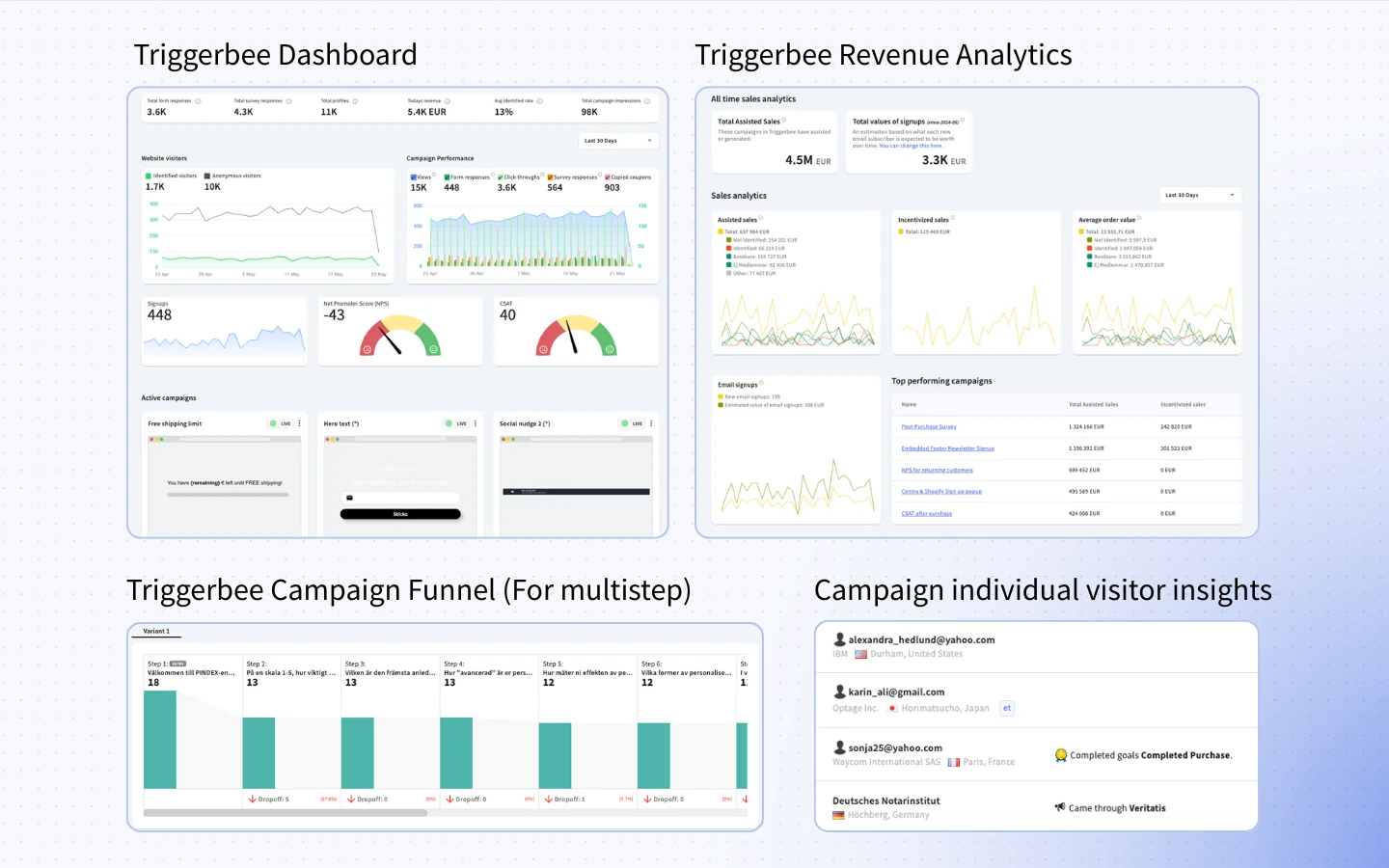
Triggerbee delivers full-funnel visibility and attribution. You get campaign-level conversion stats, individual visitor insights, NPS/CSAT results, and even revenue analytics showing assisted sales and average order values. For multistep forms, Triggerbee also visualizes each step’s drop-off rate to help you optimize flows. Data is connected back to individual profiles or CRM segments, enabling more actionable decisions across marketing and sales.
Sleeknote’s analytics
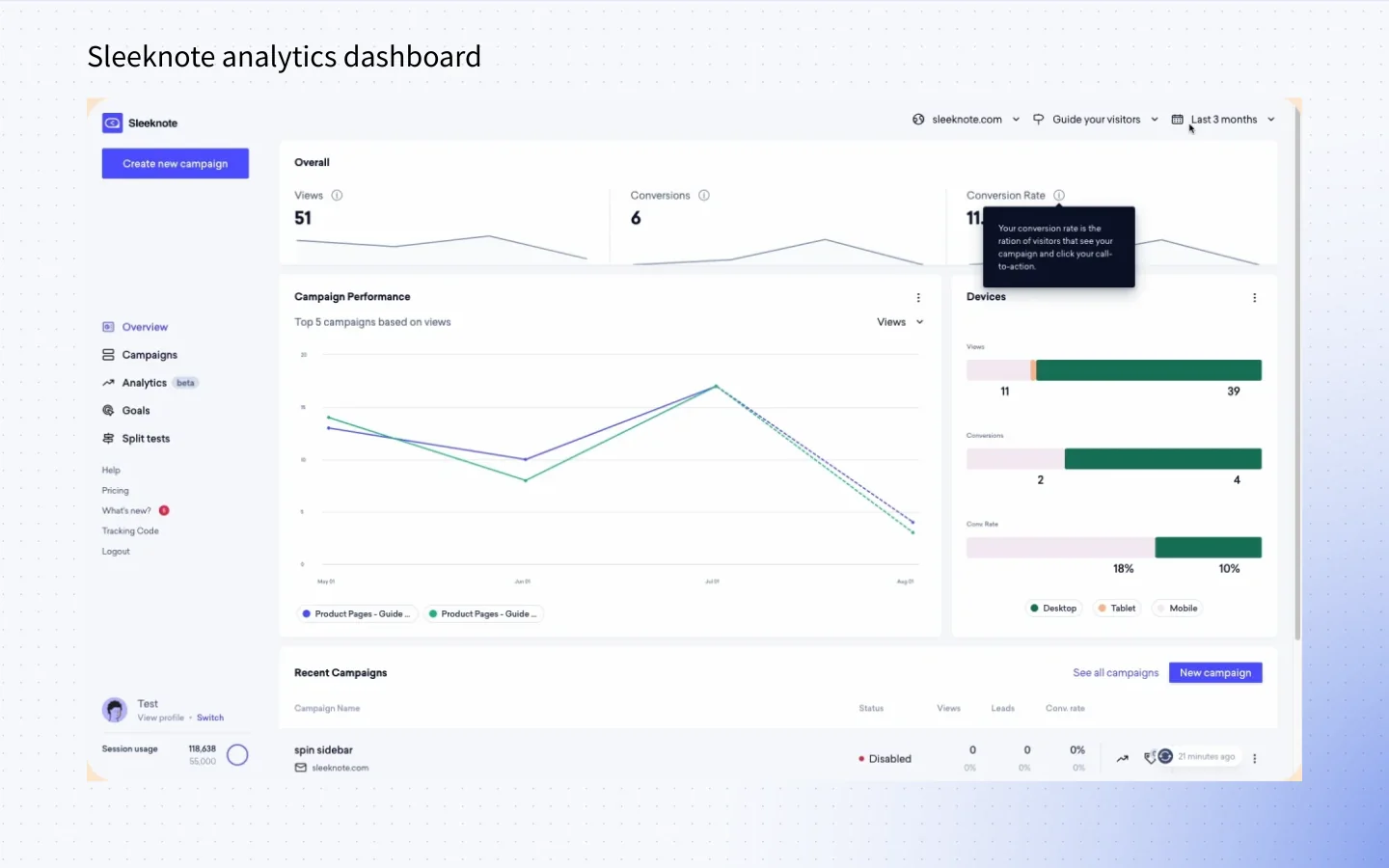
Sleeknote provides basic analytics for campaign performance. You can see overall views, conversions, and conversion rates across devices. It offers a clean visual breakdown of top campaigns, with simple tracking for goals and split testing. While it’s enough to measure general success, Sleeknote’s analytics do not include revenue attribution or detailed funnel metrics.
Verdict: Sleeknote handles the basics well for popup performance. But Triggerbee offers far more depth for serious optimization – including campaign funnels, revenue insights, and CRM-based analysis that helps you tie onsite activity to real business outcomes.
7. Pricing & Plans Comparison
Triggerbee and Sleeknote both offer scalable pricing based on traffic volume. But there’s a key difference: Sleeknote’s gamification features (like Spin to Win and Scratch to Win) are only available in a separate “Gamification” plan – which increases cost significantly.
Triggerbee, on the other hand, includes all features in both its Essential and Pro plans – so you never pay extra just to unlock interactive formats.
Here’s how the two platforms compare:
| Monthly Page Views | Triggerbee Pricing (€) | Sleeknote Pricing (€) |
|---|---|---|
| 50k | Essential: €39 | Pro: €63 | Core: €49 | Gamification: €68 |
| 100k | Essential: €63 | Pro: €96 | Core: €59 | Gamification: €80 |
| 250k | Essential: €108 | Pro: €132 | Core: €114 | Gamification: €148 |
| 500k | Essential: €137 | Pro: €216 | Contact Sales |
| 1M | Essential: €195 | Pro: €303 | Contact Sales |

Verdict: Sleeknote’s gamification unlocks come at a premium. Triggerbee includes gamified formats, surveys, revenue attribution, and CRM personalization at no extra cost in either plan.
💡 Choosing Triggerbee can save you 27% or €430 annually.
Why it’s a better deal:
- Triggerbee includes gamification, surveys, CRM-based targeting, and personalization in all plans – no need to upgrade tiers.
- You get full revenue attribution and individual visitor tracking – features that are not available in Sleeknote.
- Multistep forms, campaign funnels, and dynamic content are built in – no add-ons or hidden costs.
For any business scaling past 100k pageviews, Triggerbee offers a stronger return – both in feature depth and in cost efficiency.
8. Pros & Cons
Sleeknote Pros
- Intuitive campaign builder with solid templates
- Flexible visual editor with Shopify support
- Strong preset triggers (scroll, exit, timers)
Sleeknote Cons
- Gamification requires a more expensive plan
- No persistent personalization or CRM targeting
- Basic analytics with no revenue attribution
Triggerbee Pros
- Includes all features – no feature gating or upsells
- True one-to-one personalization with CRM sync
- Deep campaign analytics and revenue attribution
- Powerful targeting with session + profile logic
- Seamless form builder, surveys, referral tools, and gamification
Triggerbee Cons
- No freemium plan (but free trial available)
- Best suited for teams ready to use full personalization power
9. Final Verdict
Sleeknote is a solid tool for basic onsite campaigns. If you’re mainly focused on capturing emails through popups and don’t need advanced targeting or analytics, it’s a reliable choice with an easy learning curve.
But if you’re scaling, working with CRM data, or want to build personalized experiences across your website – Triggerbee is the clear winner.
✅ Triggerbee includes all premium features in every plan – including gamification, surveys, dynamic content, and real-time personalization. The only exception is Referral Marketing, which is available for Pro users.
📉 You’ll save up to 27% annually compared to Sleeknote’s gamification plans, with no compromises on functionality.
📊 You’ll gain full visibility into what’s working – including funnel tracking, revenue attribution, and segment performance.
🎯 And you’ll do it all without relying on developers or expensive integrations.
Choose Triggerbee if you want to turn your website into a personalized conversion engine – with better targeting, deeper insights, and a lower total cost of ownership.
